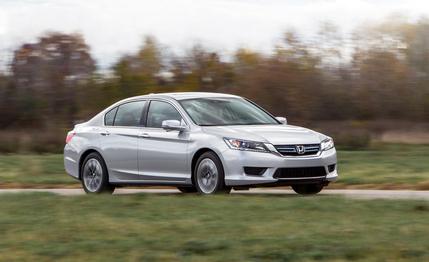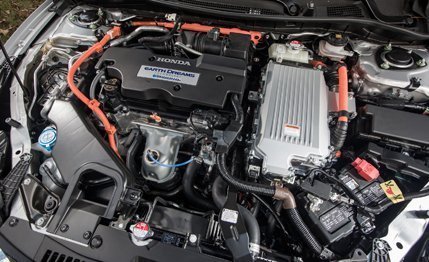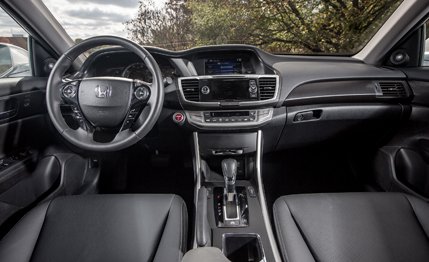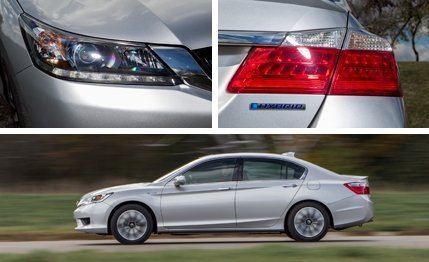
 Instrumented Test
Instrumented Test
If Lieutenant Commander Spock were shopping for a mid-size sedan, we think he’d find the Honda Accord hybrid to be an entirely logical mode of transport. Luxury-car roomy inside with a quiet cabin suitable for Vulcan cogitation: check. Cogently arrayed controls and consistently engaging vehicle dynamics: affirmative. Class-leading energy conservation: The Accord hybrid’s 50-mpg EPA city rating is particularly germane here. That’s Prius territory and not a number we’ve associated with mid-size sedans capable of comfortably transporting, say, five Klingons.
As with the Accord plug-in hybrid introduced last year, this no-plug hybrid Accord features a 141-horse Atkinson-cycle 2.0-liter four-cylinder augmented by a 166-hp AC permanent-magnet electric-drive motor. The difference is the battery. The regular hybrid doesn’t need the big lithium-ion battery the plug-in uses to achieve its 13-mile gasoline-free range, instead employing a smaller, lighter 1.3-kWh unit that gives back 4.1 cubic feet of trunk space and shaves about 200 pounds.
You’ll notice that we didn’t talk about the new Accord hybrid’s transmission because, technically, it doesn’t have one. (Head here for a deep dive on the Accord hybrid’s clever powertrain.)

 Hondas first Accord hybrid incorporated a V-6 and delivered lackluster fuel economy. This time around, Honda nailed the formula.
Hondas first Accord hybrid incorporated a V-6 and delivered lackluster fuel economy. This time around, Honda nailed the formula.
The Accord hybrid’s powertrain has three ways of moving the car: EV drive, engine drive, and hybrid drive. In EV drive, the electric drive motor powers the front wheels via energy stored in the lithium-ion battery. In engine drive, such as when cruising or accelerating lightly on a flat road at higher speeds, the 2.0-liter four helps drive the wheels through a clutch. And in hybrid drive, the engine powers a generator, which supplements the current drawn from the battery. In this mode, there is no physical connection between the engine and the drive wheels.
Hybrid mode is where this Accord spends most of its time, and here engine speed will “flare” to what the hybrid system’s brain thinks is the most efficient rpm for any given road load and throttle position. There is a prominent wail when the car accelerates briskly or climbs a grade. We were also mildly annoyed by a whirring electric-motor sound at low speeds and a slight, momentary sag when the electric motor/generator spools up the engine prior to clutch engagement as it switches from EV mode to engine-drive mode.
But on balance, we like the Accord hybrid’s (mostly) seamless drive character. Compared with its arch rival, the Camry hybrid, Honda’s planet-saver doesn’t sacrifice the driving experience on the altar of eco frugality. The Accord hybrid’s electrically boosted steering mirrors the gas-engine Accord’s steering ratio and effort, and it gives the fine-grained response we’ve come to appreciate in the nonhybrid car.


The same goes for the Accord hybrid’s new electrically assisted brakes: While totally reengineered to use mostly regenerative braking, they give crisp top-of-pedal response that’s easy to modulate. The brakes are neither grabby nor laggy like those in many other brands’ hybrids and electrics (they can get rather binary in panic snubs, however). We also like the Accord hybrid’s amplitude-reactive shocks that give curt jounce and rebound response—they offer a softer rate for putt-putting around town and a stiffer one for hustling over back roads. Low-rolling-resistance tires do sacrifice some grip, but the hybrid’s 184-foot 70-to-zero stopping distance was only four feet longer than that of the last nonhybrid Accord we tested.
Speaking of numbers, our Accord hybrid test car went from rest to 30 mph in 2.9 seconds and reached 60 in 7.2, both 0.2 second quicker than the nonhybrid Accord CVT. Not exactly warp speed, but the hybrid gains those tenths thanks to its 11-hp combined gas/electric power advantage and the electric motor’s 226 pound-feet of maximum torque just off throttle. It does this despite being 202 pounds more affected by gravity than the nonhybrid Accord.


Still, the most pertinent reason to buy the new Accord hybrid is fuel economy. Even with our typically heavy collective right foot, we saw observed mileage in the low 40s—compelling for a mid-size car. But how does it pencil out? There’s about a $3600 delta between a comparably equipped, EX-L–trimmed regular Accord and the Accord hybrid. Using the EPA-recommended guidelines of $3.50 per gallon and 15,000 miles driven per year, and calculating in the Monroney sticker’s combined EPA ratings of 30 mpg for a nonhybrid four-cylinder CVT and 47 mpg for the hybrid, the latter model’s annual fuel savings are $633. That computes to a 5.7-year break-even point, which happens after the three-year/36,000-mile bumper-to-bumper and five-year/60,000-mile powertrain warranties expire (although the expensive lithium-ion battery is warranted for a minimum of eight years and 100,000 miles).
So what’s a Vulcan to do? It doesn’t hurt that the regular Accord is a 10Best winner for the 28th time since 1983 (although the hybrid was unavailable this year). We think Spock, logically, would take the long view—one that looks at Honda’s new mainstream hybrid to conserve known fossil-fuel resources without sacrificing performance. We would be more inclined to stick with the nonhybrid Accord.
Just a few years ago, pundits were wondering how in the world 2025-model-year cars would achieve the government-mandated 54.5 mpg CAFE bogey. Now we know: without a transmission.